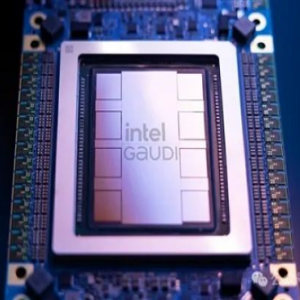
Intel's Gaudi 3 is a new generation AI training accelerator launched by Habana Labs, which is a company focused on AI chip development acquired by Intel in 2019. Intel launched the Gaudi 3 to challenge Nvidia's dominance in AI training. This article will explore the features of Intel Gaudi 3 and its potential to compete with Nvidia H20.
First, the architecture design of Intel Gaudi 3 has significant characteristics. The accelerator uses customized BU4053BCF The processor architecture supports efficient parallel computing, which is crucial to the training of deep learning models. Gaudi 3 integrates up to 96 computing cores, each of which can independently process tasks, thus achieving high throughput and low latency computing capabilities. In addition, Gaudi 3 also uses a memory architecture optimized for AI computing to support large-scale data transmission and storage. These designs enable Gaudi 3 to perform well when dealing with complex deep learning tasks.
In terms of performance, Gaudi 3 shows strong computing power. According to Intel's internal test data, Gaudi 3 has performed well in multiple deep learning benchmark tests, surpassing many competitive products in the current market. Specifically, in tasks such as image classification, natural language processing and recommendation system, Gaudi 3's training speed is several times higher than that of the previous generation, and its energy consumption is lower. This means that using Gaudi 3 for AI model training can not only shorten the training time, but also save a lot of energy costs.
Another important advantage of Intel Gaudi 3 is its efficient scalability. Gaudi 3 supports multi card parallel work. It can integrate multiple accelerators into a computing cluster through high bandwidth interconnection technology, thus significantly improving the overall computing capacity. Intel's tests show that Gaudi 3 can easily cope with the training needs of large-scale deep learning models in this way. In addition, Intel has also developed a set of optimization software tools for Gaudi 3, including compatibility optimization and performance optimization tools for deep learning framework, so that developers can use hardware resources of Gaudi 3 more efficiently.
In contrast, Nvidia H20, as its latest AI accelerator, also has very strong performance. Nvidia H20 adopts its latest Ampere architecture, integrates more than 10000 CUDA cores, and is equipped with high bandwidth video memory and advanced Tensor Core technology. These designs make H20 perform well in many AI applications, especially in the training and reasoning of deep learning models. H20 has very high efficiency and performance.
However, despite Nvidia H20's excellent performance, Intel Gaudi 3 also demonstrated its unique advantages in some aspects. The first is cost-effectiveness. According to the market analysis, the pricing of Intel Gaudi 3 may be only about half of that of Nvidia H20, which is undoubtedly an attractive choice for those users with limited budgets who need high-performance computing power. In addition, Gaudi 3 also performs well in energy efficiency ratio. Its power consumption per unit computing power is significantly lower than H20, which can significantly reduce the operating cost of data centers that need to run AI training tasks for a long time.
In addition, Intel is also actively building its AI ecosystem to provide more comprehensive support for Gaudi 3 users. Through cooperation with many AI software companies, Intel is committed to optimizing the compatibility of Gaudi 3 with mainstream deep learning frameworks, and provides detailed technical documentation and support services. This makes it easier for developers to get started and make full use of the computing power of Gaudi 3, thus accelerating the development process of AI projects.
Intel Gaudi 3 has demonstrated strong competitiveness in the AI training accelerator market. Although Nvidia H20 has advantages in performance, Gaudi 3 has become a very powerful competitor in the market with its excellent cost-effectiveness, efficient energy consumption performance and comprehensive ecosystem support. For enterprises and research institutions that want to achieve high performance and control budget in AI training, Intel Gaudi 3 is undoubtedly a choice worth considering.
In the future, as Intel continues to invest R&D resources in the AI field and continuously optimize its product performance and ecosystem, we have reason to expect Gaudi 3 and its subsequent products to achieve greater success in the market. At the same time, with the continuous development of AI technology, the market demand for high-performance and low-cost AI training accelerators will continue to grow. The competition between Intel and Nvidia will further promote the progress and innovation of the entire industry. This competition is not only conducive to technological progress, but also will bring more choices and better product experience to users.

